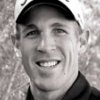What is Club Path?


Club Path is the direction the club head is moving (right or left) at impact and is measured relative to the target line.
Most golfers relate the Club Path number to hitting the ball ‘in-to-out’ or ‘out-to-in’.
A positive value means the club is moving to the right of the target at impact (‘in-to-out’ for a right-handed golfer) and a negative value means it is moving to the left of the target (‘out-to-in’ for a right-handed golfer).
To hit a straight shot, the Club Path should be zero. The Club Path is part of what influences the curvature of the shot. It also is part of what determines the ball’s starting direction.
An ‘in-to-out’ Club Path is necessary to hit a draw and an ‘out-to-in’ Club Path is necessary to hit a fade. The optimal Club Path depends on the type of shot the golfer wants to play. A golfer may want to hit a 5-yard fade, straight shot or 10-yard draw. Each of these shots has its own optimal Club Path.
Learn how to change your Club Path in this video, part of Trackman's 10 Fundamentals series.
Technical Definition:
Club Path – The horizontal direction of the club head’s geometric center movement at the time of maximum compression
A positive value means the club is moving to the right of the target line regardless of dexterity
A negative value means the club is moving to the left of the target line regardless of dexterity
A must-read blog post on this topic:
When Lining Up Square is Wrong — by guest author Tom Stickney
The standard assumption for Club Path is zero for all clubs. It is a standard assumption that the ball starts straight at the target and has no curvature (zero spin axis).
What our Trackman Masters say about Club Path…
“My preference is to see Club Path numbers within a +/- 3-6 degree range, depending on whether the golfer wants to play a fade or draw. I do not like to see golfers with a path of zero. With a Club Path of zero, the slightest negative Face Angle will create a negative spin axis and curve the ball away from the target. The same goes for a zero Club Path and a positive Face Angle. This will create a positive spin axis and curve the ball away from the target as well.”

Christoph Bausek
Progressive Golf, Austria
“One of the very first parameters I observe with all golfers is Club Path. Club Path references the direction the club head is moving at the moment of collision. If the path is moving in an excessively negative (out-to-in) or positive (in-to-out) direction, then the golfer is going to require a Face Angle compensation to get the ball flying towards the target. This will often cause a big separation between the Face Angle and Club Path, resulting in excessive curvature and inconsistent ball flight.”

Richard Woodhouse
KDV Sports, Australia
“In a single lesson, I have helped golfers make changes to their golf swings that may have taken a full lesson package in the past. When a golfer sees their Club Path number change through a drill or a change in concept, they trust that they are on the right track and commit to making the change permanent.”

Joel Mercieca
KDV Sports, Australia